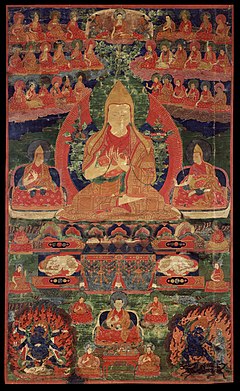
Back Gelug Afrikaans غيلوغ Arabic Гелуг-па Byelorussian Гелугпа Bulgarian དགེ་ལུགས་པ། Tibetan Гэлүгбэ BXR Gelug Catalan Gelugpa Czech Gelug German Gelugo Esperanto


The Gelug (/ɡəˈluːɡ/, also Geluk; lit. "virtuous")[1] is the newest of the four major schools of Tibetan Buddhism.[2] It was founded by Je Tsongkhapa (1357–1419), a Tibetan philosopher, tantric yogi and lama and further expanded and developed by his disciples (such as Khedrup Je, Gyaltsap Je, Dulzin Drakpa Gyaltsen, and Gendün Drubpa).[1]
The Gelug school is alternatively known as Kadam (bKa’-gdams gsar-pa), since it sees itself as a continuation of the Kadam tradition of Atisha (c. 11th century). The school of New Kadam, or New Kadampa is an offshoot of the Gelug-tradition.[3] Furthermore, it is also called the Ganden school, after the first monastery established by Tsongkhapa.[1] The Ganden Tripa ("Ganden Throne Holder") is the official head of the school, though its most influential political figure is the Dalai Lama ("Ocean Teacher"). Allying themselves with the Mongol Khans, the Gelug school emerged as the dominant Buddhist school in Tibet and Mongolia since the end of the 16th century (religiously and politically). Another alternative name for this tradition is the Yellow Hat school or sect.[4]
Doctrinally, the Gelug school promotes a unique form of prasangika Madhyamaka based on the works of Tsongkhapa. According to John Powers, Tsongkhapa's work "contains a comprehensive view of Buddhist philosophy and practice that integrates sutra and tantra, analytical reasoning, and yogic meditation."[5]
- ^ a b c Kay, David N. (2007). Tibetan and Zen Buddhism in Britain: Transplantation, Development and Adaptation, p. 39. Routledge.
- ^ Schaik, Sam van. Tibet: A History. Yale University Press 2011, page 129.
- ^ https://info-buddhismus.de/new_kadampa_tradition.html
- ^ Alexander Berzin, The Origin of the Yellow Hat, Berzin Archives, retrieved 18 September 2020.
- ^ Powers, John (2007) Introduction to Tibetan Buddhism, p. 467. Snow Lion Publications.
© MMXXIII Rich X Search. We shall prevail. All rights reserved. Rich X Search